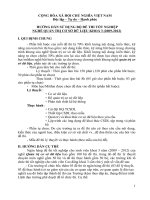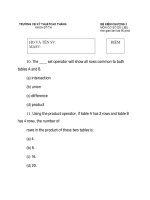Đề thi trắc nghiệm cơ sở dữ liệu trường Cao Thắng - phần 6 ppt
Bạn đang xem bản rút gọn của tài liệu. Xem và tải ngay bản đầy đủ của tài liệu tại đây (184.39 KB, 6 trang )
31. The following query will execute without errors:
select customer.customer_name, salesman.sales_quota
from customer
where customer.salesman_id =
(select salesman_id
from salesman
where lname = ‘SMITH’);
a.TRUE
b.FALSE
32. Table TT {J , D , C , V , N , G } and a set of functional
dependencies
J,C,N → V,G
D → C,V,G
J → D,C,G
The closure of {D } is:
Giáo Trình Cơ Sở Dữ Liệu Trang 102
Biên soạn : Phan Tấn Quốc- Trường Cao Đẳng Kỹ Thuật Cao Thắng
a) J D C V N G
b) J D C V G
c) J C V G
d) D C V N
e) D C V G
33. Table TT {O , M , Z , I , Q } and a set of functional dependencies
O → I,Q
I → M,Z
O,Z → M
Table TT is:
a) 1 NF
b) 2 NF
c) 3 NF
34. For which task in SQL would you use an IN clause
(a) To query the database for unknown values
(b) To query the database for a range of values
(c) To query the database for a character pattern
(d) To query the database for values in a specified list
35. A Cartesian product is
(a) A group function
(b) Produced as a result of a join select statement with no where
clause
(c) The result of fuzzy logic
(d) A special feature of Oracle Server
36. A type of query that is placed within a WHERE or HAVING
clause of another query is called
a:
(a) master query.
(b) subquery.
(c) superquery.
(d) multi-query.
37. In order to perform a join, which criteria must be true?
Giáo Trình Cơ Sở Dữ Liệu Trang 103
Biên soạn : Phan Tấn Quốc- Trường Cao Đẳng Kỹ Thuật Cao Thắng
(a) The two tables must have the exact same columns.
(b) The tables in the join need to have common rows.
(c) The two tables must both have primary keys
(d) The two tables must have at least one common column.
38. An attribute(s) which uniquely determines a tuple within a
relation is called a:
(a) Candidate key
(b) Foreign key
(c) Primary key
(d) All of the above
(e) A and C
39. Table Q(A,B,C) and a set of functional dependencies
AB → C;
C → A;
Table Q is:
a) 1 NF
b) 2 NF
c) 3 NF
d) BCNF
40. Table Q(A,B,C,D) and a set of functional dependencies
AB → C;
D → B;
C → AD
Table Q is:
a) 1 NF
e) 2 NF
f) 3 NF
g) BCNF
41. The following table and functional dependencies exhibits what
type of dependency?
Table(A, B, C)
A -> C
A -> B
B -> C
(a) Partial Dependence
(b) Transitive Dependence
(c) Full Dependence
(d) A and B
(e) None of the above









